Xiuming Zhang
A Multimodal Foundation Model to Enhance Generalizability and Data Efficiency for Pan-cancer Prognosis Prediction
Sep 16, 2025Abstract:Multimodal data provides heterogeneous information for a holistic understanding of the tumor microenvironment. However, existing AI models often struggle to harness the rich information within multimodal data and extract poorly generalizable representations. Here we present MICE (Multimodal data Integration via Collaborative Experts), a multimodal foundation model that effectively integrates pathology images, clinical reports, and genomics data for precise pan-cancer prognosis prediction. Instead of conventional multi-expert modules, MICE employs multiple functionally diverse experts to comprehensively capture both cross-cancer and cancer-specific insights. Leveraging data from 11,799 patients across 30 cancer types, we enhanced MICE's generalizability by coupling contrastive and supervised learning. MICE outperformed both unimodal and state-of-the-art multi-expert-based multimodal models, demonstrating substantial improvements in C-index ranging from 3.8% to 11.2% on internal cohorts and 5.8% to 8.8% on independent cohorts, respectively. Moreover, it exhibited remarkable data efficiency across diverse clinical scenarios. With its enhanced generalizability and data efficiency, MICE establishes an effective and scalable foundation for pan-cancer prognosis prediction, holding strong potential to personalize tailored therapies and improve treatment outcomes.
Genome-Anchored Foundation Model Embeddings Improve Molecular Prediction from Histology Images
Jun 24, 2025Abstract:Precision oncology requires accurate molecular insights, yet obtaining these directly from genomics is costly and time-consuming for broad clinical use. Predicting complex molecular features and patient prognosis directly from routine whole-slide images (WSI) remains a major challenge for current deep learning methods. Here we introduce PathLUPI, which uses transcriptomic privileged information during training to extract genome-anchored histological embeddings, enabling effective molecular prediction using only WSIs at inference. Through extensive evaluation across 49 molecular oncology tasks using 11,257 cases among 20 cohorts, PathLUPI demonstrated superior performance compared to conventional methods trained solely on WSIs. Crucially, it achieves AUC $\geq$ 0.80 in 14 of the biomarker prediction and molecular subtyping tasks and C-index $\geq$ 0.70 in survival cohorts of 5 major cancer types. Moreover, PathLUPI embeddings reveal distinct cellular morphological signatures associated with specific genotypes and related biological pathways within WSIs. By effectively encoding molecular context to refine WSI representations, PathLUPI overcomes a key limitation of existing models and offers a novel strategy to bridge molecular insights with routine pathology workflows for wider clinical application.
PathBench: A comprehensive comparison benchmark for pathology foundation models towards precision oncology
May 26, 2025Abstract:The emergence of pathology foundation models has revolutionized computational histopathology, enabling highly accurate, generalized whole-slide image analysis for improved cancer diagnosis, and prognosis assessment. While these models show remarkable potential across cancer diagnostics and prognostics, their clinical translation faces critical challenges including variability in optimal model across cancer types, potential data leakage in evaluation, and lack of standardized benchmarks. Without rigorous, unbiased evaluation, even the most advanced PFMs risk remaining confined to research settings, delaying their life-saving applications. Existing benchmarking efforts remain limited by narrow cancer-type focus, potential pretraining data overlaps, or incomplete task coverage. We present PathBench, the first comprehensive benchmark addressing these gaps through: multi-center in-hourse datasets spanning common cancers with rigorous leakage prevention, evaluation across the full clinical spectrum from diagnosis to prognosis, and an automated leaderboard system for continuous model assessment. Our framework incorporates large-scale data, enabling objective comparison of PFMs while reflecting real-world clinical complexity. All evaluation data comes from private medical providers, with strict exclusion of any pretraining usage to avoid data leakage risks. We have collected 15,888 WSIs from 8,549 patients across 10 hospitals, encompassing over 64 diagnosis and prognosis tasks. Currently, our evaluation of 19 PFMs shows that Virchow2 and H-Optimus-1 are the most effective models overall. This work provides researchers with a robust platform for model development and offers clinicians actionable insights into PFM performance across diverse clinical scenarios, ultimately accelerating the translation of these transformative technologies into routine pathology practice.
SEW: Self-calibration Enhanced Whole Slide Pathology Image Analysis
Dec 14, 2024



Abstract:Pathology images are considered the "gold standard" for cancer diagnosis and treatment, with gigapixel images providing extensive tissue and cellular information. Existing methods fail to simultaneously extract global structural and local detail f
Efficient and Comprehensive Feature Extraction in Large Vision-Language Model for Clinical Pathology Analysis
Dec 12, 2024Abstract:Pathological diagnosis is vital for determining disease characteristics, guiding treatment, and assessing prognosis, relying heavily on detailed, multi-scale analysis of high-resolution whole slide images (WSI). However, traditional pure vision models face challenges of redundant feature extraction, whereas existing large vision-language models (LVLMs) are limited by input resolution constraints, hindering their efficiency and accuracy. To overcome these issues, we propose two innovative strategies: the mixed task-guided feature enhancement, which directs feature extraction toward lesion-related details across scales, and the prompt-guided detail feature completion, which integrates coarse- and fine-grained features from WSI based on specific prompts without compromising inference speed. Leveraging a comprehensive dataset of 490,000 samples from diverse pathology tasks-including cancer detection, grading, vascular and neural invasion identification, and so on-we trained the pathology-specialized LVLM, OmniPath. Extensive experiments demonstrate that this model significantly outperforms existing methods in diagnostic accuracy and efficiency, offering an interactive, clinically aligned approach for auxiliary diagnosis in a wide range of pathology applications.
DiffusionRig: Learning Personalized Priors for Facial Appearance Editing
Apr 13, 2023



Abstract:We address the problem of learning person-specific facial priors from a small number (e.g., 20) of portrait photos of the same person. This enables us to edit this specific person's facial appearance, such as expression and lighting, while preserving their identity and high-frequency facial details. Key to our approach, which we dub DiffusionRig, is a diffusion model conditioned on, or "rigged by," crude 3D face models estimated from single in-the-wild images by an off-the-shelf estimator. On a high level, DiffusionRig learns to map simplistic renderings of 3D face models to realistic photos of a given person. Specifically, DiffusionRig is trained in two stages: It first learns generic facial priors from a large-scale face dataset and then person-specific priors from a small portrait photo collection of the person of interest. By learning the CGI-to-photo mapping with such personalized priors, DiffusionRig can "rig" the lighting, facial expression, head pose, etc. of a portrait photo, conditioned only on coarse 3D models while preserving this person's identity and other high-frequency characteristics. Qualitative and quantitative experiments show that DiffusionRig outperforms existing approaches in both identity preservation and photorealism. Please see the project website: https://diffusionrig.github.io for the supplemental material, video, code, and data.
Bone marrow sparing for cervical cancer radiotherapy on multimodality medical images
Apr 20, 2022
Abstract:Cervical cancer threatens the health of women seriously. Radiotherapy is one of the main therapy methods but with high risk of acute hematologic toxicity. Delineating the bone marrow (BM) for sparing using computer tomography (CT) images to plan before radiotherapy can effectively avoid this risk. Comparing with magnetic resonance (MR) images, CT lacks the ability to express the activity of BM. Thus, in current clinical practice, medical practitioners manually delineate the BM on CT images by corresponding to MR images. However, the time?consuming delineating BM by hand cannot guarantee the accuracy due to the inconsistency of the CT-MR multimodal images. In this study, we propose a multimodal image oriented automatic registration method for pelvic BM sparing, which consists of three-dimensional bone point cloud reconstruction, a local spherical system iteration closest point registration for marking BM on CT images. Experiments on patient dataset reveal that our proposed method can enhance the multimodal image registration accuracy and efficiency for medical practitioners in sparing BM of cervical cancer radiotherapy. The method proposed in this contribution might also provide references for similar studies in other clinical application.
SunStage: Portrait Reconstruction and Relighting using the Sun as a Light Stage
Apr 07, 2022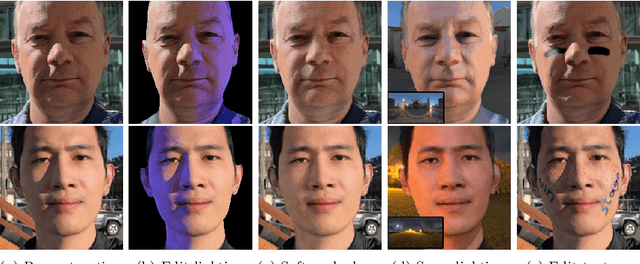
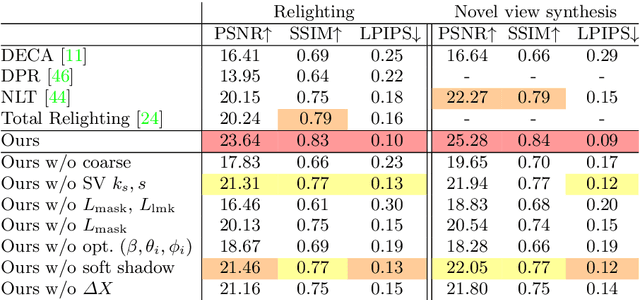
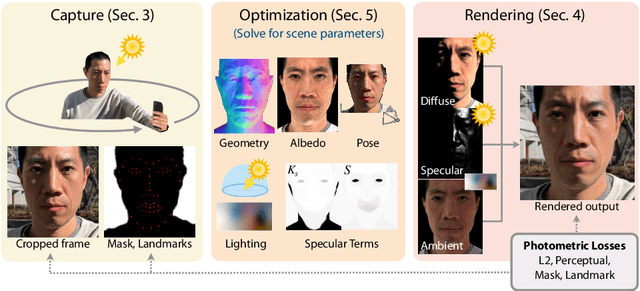
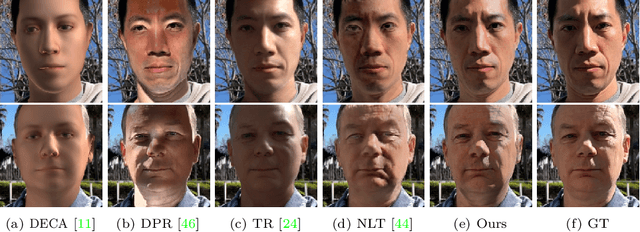
Abstract:Outdoor portrait photographs are often marred by the harsh shadows cast under direct sunlight. To resolve this, one can use post-capture lighting manipulation techniques, but these methods either require complex hardware (e.g., a light stage) to capture each individual, or rely on image-based priors and thus fail to reconstruct many of the subtle facial details that vary from person to person. In this paper, we present SunStage, a system for accurate, individually-tailored, and lightweight reconstruction of facial geometry and reflectance that can be used for general portrait relighting with cast shadows. Our method only requires the user to capture a selfie video outdoors, rotating in place, and uses the varying angles between the sun and the face as constraints in the joint reconstruction of facial geometry, reflectance properties, and lighting parameters. Aside from relighting, we show that our reconstruction can be used for applications like reflectance editing and view synthesis. Results and interactive demos are available at https://grail.cs.washington.edu/projects/sunstage/.
Edge-competing Pathological Liver Vessel Segmentation with Limited Labels
Aug 01, 2021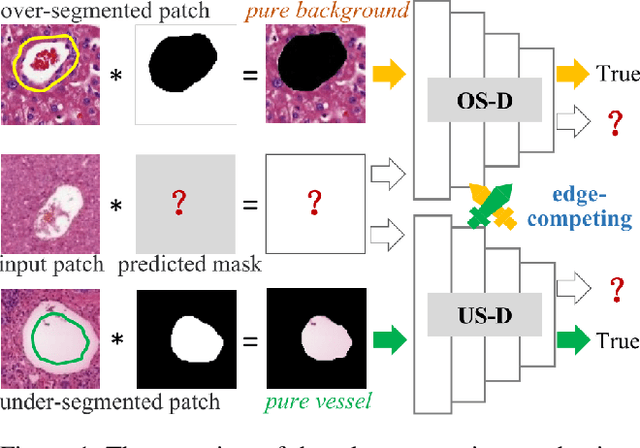



Abstract:The microvascular invasion (MVI) is a major prognostic factor in hepatocellular carcinoma, which is one of the malignant tumors with the highest mortality rate. The diagnosis of MVI needs discovering the vessels that contain hepatocellular carcinoma cells and counting their number in each vessel, which depends heavily on experiences of the doctor, is largely subjective and time-consuming. However, there is no algorithm as yet tailored for the MVI detection from pathological images. This paper collects the first pathological liver image dataset containing 522 whole slide images with labels of vessels, MVI, and hepatocellular carcinoma grades. The first and essential step for the automatic diagnosis of MVI is the accurate segmentation of vessels. The unique characteristics of pathological liver images, such as super-large size, multi-scale vessel, and blurred vessel edges, make the accurate vessel segmentation challenging. Based on the collected dataset, we propose an Edge-competing Vessel Segmentation Network (EVS-Net), which contains a segmentation network and two edge segmentation discriminators. The segmentation network, combined with an edge-aware self-supervision mechanism, is devised to conduct vessel segmentation with limited labeled patches. Meanwhile, two discriminators are introduced to distinguish whether the segmented vessel and background contain residual features in an adversarial manner. In the training stage, two discriminators are devised tocompete for the predicted position of edges. Exhaustive experiments demonstrate that, with only limited labeled patches, EVS-Net achieves a close performance of fully supervised methods, which provides a convenient tool for the pathological liver vessel segmentation. Code is publicly available at https://github.com/zju-vipa/EVS-Net.
Editing Conditional Radiance Fields
Jun 04, 2021



Abstract:A neural radiance field (NeRF) is a scene model supporting high-quality view synthesis, optimized per scene. In this paper, we explore enabling user editing of a category-level NeRF - also known as a conditional radiance field - trained on a shape category. Specifically, we introduce a method for propagating coarse 2D user scribbles to the 3D space, to modify the color or shape of a local region. First, we propose a conditional radiance field that incorporates new modular network components, including a shape branch that is shared across object instances. Observing multiple instances of the same category, our model learns underlying part semantics without any supervision, thereby allowing the propagation of coarse 2D user scribbles to the entire 3D region (e.g., chair seat). Next, we propose a hybrid network update strategy that targets specific network components, which balances efficiency and accuracy. During user interaction, we formulate an optimization problem that both satisfies the user's constraints and preserves the original object structure. We demonstrate our approach on various editing tasks over three shape datasets and show that it outperforms prior neural editing approaches. Finally, we edit the appearance and shape of a real photograph and show that the edit propagates to extrapolated novel views.
 Add to Chrome
Add to Chrome Add to Firefox
Add to Firefox Add to Edge
Add to Edge